About the Chop Cup
by Doug Atkinson Last
Updated Jan 2018
The Chop cup is one of my favorite effects, along with the color
changing knives. I'm not sure why, but it may be because of the
simplicity of a single cup and ball. The popularity of the Chop
Cup is credited to Mr. Al "Chop Chop" Wheatley, although there are
a couple of earlier references to a Chop Cup style in earlier
works. There is a good discussion of this on The Magic Cafe here:
http://www.themagiccafe.com/forums/viewtopic.php?topic=278553&forum=115,
with input from Bill Palmer, Lawrence O, Pete Biro, and Jake from
RNT2, among others. Also, Mike Rose is working on a biography of
Mr. Wheatley (see http://mikerosemagic.com/al-wheatley/).
The Chop cup is a single cup and ball routine that uses a
gimmicked cup. Typically, a small ball is made to appear and
disappear underneath the cup, and routines usually climax with the
appearance of a large ball or other object under the cup.
While most Chop cup routines utilize a single cup, some Chop cups
come as part of a Three Cups & Balls set, with one (or more)
cups gimmicked as a Chop cup. These sets are usually called "combo
cups and balls" sets. There are also a few two cup sets out
there.
Since single Chop cups don't have to nest with any other cups,
however, their size and shape can vary quite a bit from the cups
used for the cups and balls. You can find leather chop cups that
might be suitable for a Rennaisance fair, wooden chop cups for a
sophisticated look, soda or beer cans for familiarity, and cups
with a stem, for example. Chop cups also come in a variety of
sizes, from small shot-glass sized cups to cups large enough to
hold a baseball.
You can even make your own chop cup, and you can do an almost
"impromptu" chop cup routine if you use a paper cup and a special
magician's ring such as the Omega ring, "PK" ring, or similar.
Chop cup routines range from simple single cup and ball routines
with a large load climax, to routines that incorporate a shot
glass and handkerchief, and of course routines that use two or
more cups. There are routines that use two or even three chop
cups.
One of my favorite routines is Don Alan's. His performance on the
Magic Ranch video series is excellent. You can purchase the
routine from a variety of sources. A quick few page description of
the routine is available from Magic
Inc. You can also find the short version in Lot's of Lawton by Don
Lawton. Jon Racherbaumer provides a bit more description in his
book about Don Alan, In a
Class By Himself, The Legacy of Don Alan; this version
includes some photos. In 2005, Ron Bauer pubished The Complete Don Alan's Chop Cup
that includes a full step by step description and analysis of
every move.
The late Dennis Loomis has a routine based on Don Alan's that was
offered as the Routine for
the James Riser/ Dennis Loomis Micro Chop Cup (also a
great small Chop Cup, but sadly no longer available). The
routine, however, will work with other cups as well. The Merlyn
Shute How to Book of the Chop
Cup is an excellent inexpensive introduction to the Chop
cup. Larry Jenning's routine incorporating a shot glass and silk
(as found in On Card and Coin
Handling) is also very good. I have certainly not read
all of the available Chop Cup routines, so these are just a few to
get you started.
As for videos, there is a World's Greatest Magic sereis from
L&L publishing dedicated to the Chop Cup, along with the many
other references you can see in the reference guide.
For a routine to use with the combo cups, John Mendoza offers a
good one that was available from Morrissey Magic out of Canada.
Although Morrissey has gone out of business, I believe the routine
is still available from many shops.
As for products, there are a lot to choose from as found on the products list reference page. In general,
a Chop cup that is not part of a cups & balls set is probably
a good idea. A stand alone chop cup tends to have steeper sides
that lend themselves to Chop cup routines better. However, if you
are just starting out with Chop cups and cups & balls, you may
want to use a combo set so you can experiment with both. Also, as
mentioned above, a combo set lets you do a few things that would
be impossible with a standard cups & balls set.
Chop Cup Images;
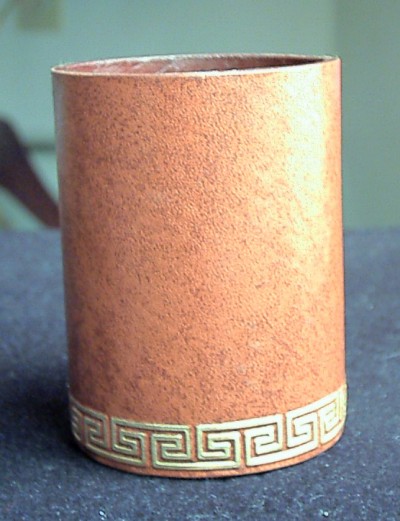 |
Leather Chop Cup: Unknown manufacturer
This is a hard leather chop cup I purchased used from Tom
Ladshaw (one of two). I don't know the manufacturer, but the
cup is well made. It is rigid in construction with straight
sides like a dice cup. I have since sold this one. |
Leather Chop Cup of Unknown manufacturer 2.
This is the second of two rigid leather chop cups I
purchased from Tom Ladshaw some years ago. The two cups are
almost identical in design, just differing in the amount of
ornation in the leather. I sold one and decided to keep this
one. If anyone knows who made these, I'd love to know! |
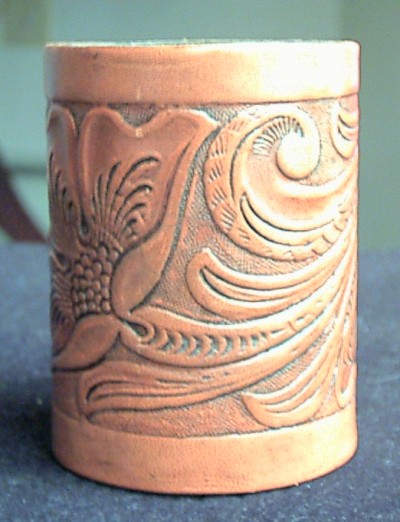 |
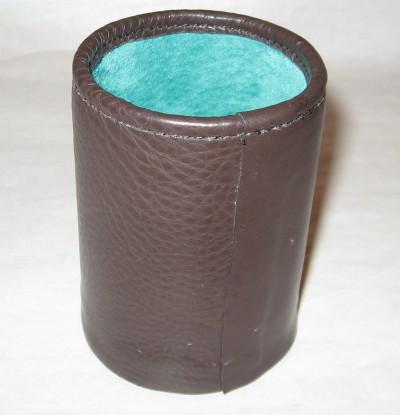 |
The Ambitious Card - Frank Starsinic
This is an early version of one of Frank's rigid leather
chop cups that functions also as a dice cup. Frank has since
developed many versions |
| Kaymar Magic Company Professional Chop Cup (Leather) from
Essex, U.K. Purchased in the 1980's (if I remember
correctly). Seam is quite loose; fit and finish are not
exceptional, but is effective as a "primitive" cup. |
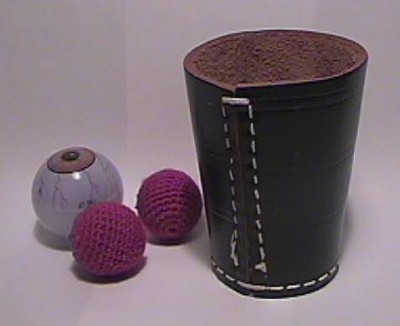 |
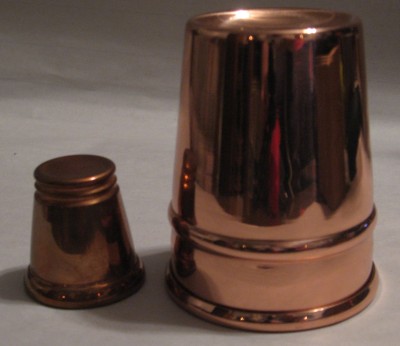 |
James Riser / Dennis Loomis Micro Chop Cup (next to a
Magic Inc. Cup to show size). Introduced in 2003, this
small, well made cup is no longer available. The cups came
in two varieties: Copper Cup (shown here) or a Stainless
Steel Cup. Came with Dennis' excellent book on the Micro
Chop Cup. A full kit including a stainless hip-flask
and four load balls was also available for a liquid vanish
climax. |
| Greg Wilson's Kiss Off. This single cup & ball routine
used two huge Hershey Kisses and a Hershey's can in this
"Beenie Weenie" type of routine. Routine ends with a full
can of syrup. Was only available for a short time because
the cans of syrup became unavailable. Produced by
MagicSmith. |
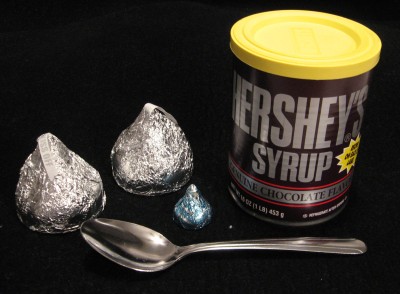 |
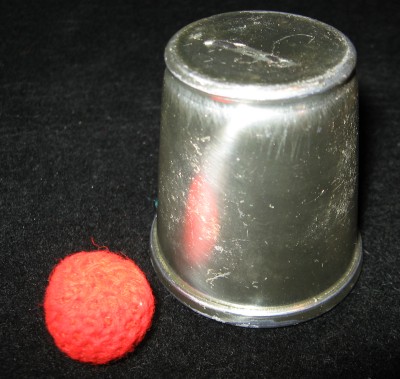 |
Small Aluminum Chop Cup: Unknown manufacturer. This one is
pretty beat up but functions okay. As you can see, there is
no indent on the inverted bottom, making resting a ball on
it a bit more difficult. |
Ceramic Chop Coffee Mug. Some people like this type of
Chop Cup the best as it is totally "natural". Especially
useful if everyone already is using a different type of mug,
so that this one won't stick out. The "Wizard's Brand" on
the bottom might be a bit of a give-away, but could be
easily removed.
This cup was a lesson for me. I had the cup for years, and
almost got rid of it a few times. I thought the magnet had
been weakened, perhaps by heating in a dishwasher or
something. I would drop a ball in and it would barely stay.
I recently took it out to take this photograph, and when
playing with it realized that the gimmick is positioned near
the handle rather than the center. This allows the ball to
be dropped out or
kept in as you desire, simply by keeping track of the way
the cup is held. The handle makes it easy. It was almost
like getting a new Chop Cup! |
 |
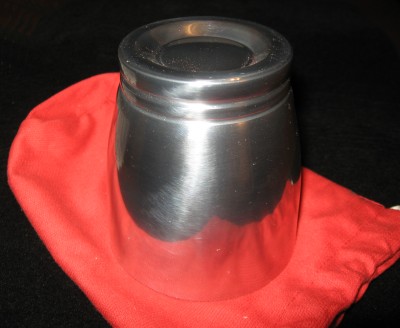 |
Don Alan Style Chop Cup, Maker Unknown. I got this cup
some time ago and don't know who made it. It holds a very
large load and is made of aluminum. |
| Plastic Chop Cup: A glitzy plastic Chop Cup. I pretty much
hate this cup. Cost was about $5. |
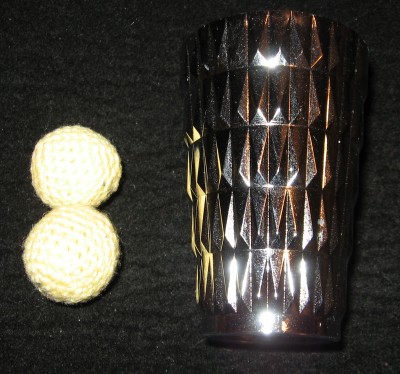 |
 |
Russian Chop Cup
from Paul Howard Pro Magic
(U.K.) and Brian Le Slie. This cup does not work on the
normal Chop Cup principle, but rather on the old "marble
vase" principle. I was a bit disappointed in the color of
the balls, which are too close to flesh colored, and the
lack of quality instructions. The Russian Doll is a bit
noisy to load, and there are no tips or guidance on
performing this load effectively. The instruction sheet is a
single-sided 8.5x11" sheet with no illustrations. It
includes such valuable insight such as "Now secretly let the
newly produced ball return inside the cup and expose the
palmed ball. Both hands should meet to do this quickly..."
I think this is an effect in which the routining must be
carefully thought out as the "working" is something the
audience will suspect if the routine does not take attention
away from it. My 8 year old daughter got a hold of this, and
right away she started trying to do this the right way. She
jammed the ball in too tightly so thought she wasn't doing
it right, but an adult would certainly catch on unless the
presentation effectively distracts from the method. |
Magic Home Page
MAGIC
HOME Magic Links










